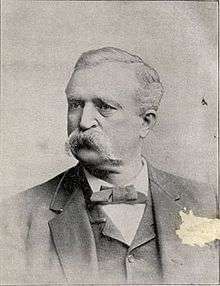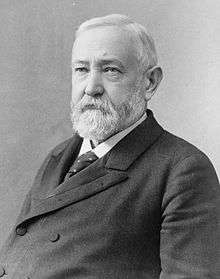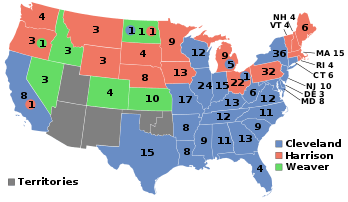1892 United States presidential election in Idaho
The 1892 United States presidential election in Idaho took place on November 8, 1892. All contemporary 44 states were part of the 1892 United States presidential election. State voters chose three electors to the Electoral College, which selected the president and vice president.
| ||||||||||||||||||||||||||
| ||||||||||||||||||||||||||
| ||||||||||||||||||||||||||
| Elections in Idaho | ||||||||
|---|---|---|---|---|---|---|---|---|
 | ||||||||
|
||||||||
|
||||||||
Background
This was the first time Idaho participated in a presidential election, having become the 43rd state on July 3, 1890. During its period as a territory Idaho had been divided between a strongly Republican northern half and an anti-Republican Mormon south,[1] which in this first Presidential election was in places (notably Oneida County) still excluded from voting.[1]
A wave of strikes in the silver-mining regions[2] and even deeper conflict whereby an idled ore concentrator was destroyed in Gem,[3] was to give the Populists a grip on the Mountain West that was not to be relinquished. Almost all the large number of dissenting farmers in the new state were to join with the silver interests[4] to back Weaver's policies of nationalization of railways and communications, restriction of immigration, shorter working days and direct election of Senators.[5] Although Senator-to-be William Borah campaigned for Harrison under the slogan that “a vote for Weaver was a vote for Cleveland and therefore against their own interests”[6] Weaver's campaign against Republican Governor Norman Bushnell Willey’s declaration of martial law upon the miners, and against the absentee ownership of Idaho's land and water,[7] ensured that these campaigns for Harrison would not be decisive.
Vote
Owing to the unpopularity in the West of his gold standard platform, the Democratic Party decided to not enter a Cleveland ticket in the race and to back Weaver.[8] Idaho was won by the Populist nominees, James B. Weaver of Iowa and his running mate James G. Field of Virginia. Weaver and Field defeated the Republican nominees, incumbent President Benjamin Harrison of Indiana and his running mate Whitelaw Reid of New York.
Results
| 1892 United States presidential election in Idaho[9] | |||||
|---|---|---|---|---|---|
| Party | Candidate | Votes | Percentage | Electoral votes | |
| People's | James Weaver | 10,520 | 54.21% | 3 | |
| Republican | Benjamin Harrison (incumbent) | 8,599 | 44.31% | 0 | |
| Prohibition | John Bidwell | 288 | 1.48% | 0 | |
| Totals | 19,407 | 100.00% | 3 | ||
| Voter turnout | — | ||||
Results by county
| County | Benjamin Harrison[10] Republican |
James Baird Weaver[11] People's |
John Bidwell[12] Prohibition |
Margin | Total votes cast | ||||
|---|---|---|---|---|---|---|---|---|---|
| # | % | # | % | # | % | # | % | ||
| Ada | 1,170 | 41.39% | 1,597 | 56.49% | 60 | 2.12% | -427 | -15.10% | 2,827 |
| Alturas | 290 | 32.66% | 596 | 67.12% | 2 | 0.23% | -306 | -34.46% | 888 |
| Bear Lake | 114 | 33.93% | 220 | 65.48% | 2 | 0.60% | -106 | -31.55% | 336 |
| Bingham | 937 | 48.35% | 933 | 48.14% | 68 | 3.51% | 4 | 0.21% | 1,938 |
| Boise | 377 | 42.60% | 500 | 56.50% | 8 | 0.90% | -123 | -13.90% | 885 |
| Cassia | 121 | 39.16% | 173 | 55.99% | 15 | 4.85% | -52 | -16.83% | 309 |
| Custer | 187 | 36.45% | 324 | 63.16% | 1 | 0.19% | -137 | -26.71% | 513[lower-alpha 1] |
| Elmore | 188 | 34.81% | 351 | 65.00% | 1 | 0.19% | -163 | -30.19% | 540 |
| Idaho | 386 | 46.01% | 448 | 53.40% | 5 | 0.60% | -62 | -7.39% | 839 |
| Kootenai | 713 | 47.95% | 753 | 50.64% | 21 | 1.41% | -40 | -2.69% | 1,487 |
| Latah | 1,242 | 45.46% | 1,432 | 52.42% | 58 | 2.12% | -190 | -6.95% | 2,732 |
| Lemhi | 330 | 57.39% | 244 | 42.43% | 1 | 0.17% | 86 | 14.96% | 575 |
| Logan | 306 | 36.69% | 518 | 62.11% | 9 | 1.08% | -212 | -25.42% | 834[lower-alpha 1] |
| Nez Perce | 345 | 44.23% | 428 | 54.87% | 7 | 0.90% | -83 | -10.64% | 780 |
| Oneida | 267 | 63.88% | 137 | 32.78% | 14 | 3.35% | 130 | 31.10% | 418 |
| Owyhee | 337 | 49.34% | 340 | 49.78% | 6 | 0.88% | -3 | -0.44% | 683 |
| Shoshone | 936 | 48.95% | 971 | 50.78% | 5 | 0.26% | -35 | -1.83% | 1,912 |
| Washington | 317 | 36.15% | 555 | 63.28% | 5 | 0.57% | -238 | -27.14% | 877 |
| Totals | 8,563 | 44.21% | 10,520 | 54.31% | 288 | 1.49% | -1,957 | -10.10% | 19,371 |
Notes
- One write-in vote was recorded in this county for Democratic President Grover Cleveland.
References
- Idaho Historical Society (1988); ‘Idaho Yesterdays’, vol. 32, p. 13
- Kennedy, David M. and Cohen, Lizabeth; American Pageant, Volume 2, p. 506 ISBN 1305537416
- Schwantes, Carlos A.; The Pacific Northwest: An Interpretive History, p. 343
- Martin, Boyd Archer (1975); Idaho Voting Trends: Party Realignment and Percentage of Votes for Candidates, Parties, and Elections, 1890-1974, p. 373
- Kennedy and Cohen; American Pageant, Volume 2, p. 505
- Johnson, Claudius O.; ‘The Story of Silver Politics in Idaho, 1892-1902’; The Pacific Northwest Quarterly, vol. 33, no. 3 (July 1942), pp. 283-296
- Larson, Robert W.; ‘Populism in the Mountain West: A Mainstream Movement’; Western Historical Quarterly, vol. 13, no. 2 (April 1982), pp. 143-164
- The Society (1974); State Historic Preservation Plan, Idaho, Volume 1, p. 72
- Dave Leip's U.S. Election Atlas; 1892 Presidential General Election Results – Idaho
- Géoelections; Presidential election of 1892 Popular Vote (.xlsx file for €15)
- Géoelections; Popular Vote for James B. Weaver (.xlsx file for €15)
- Géoelections; Popular Vote for John Bidwell (.xlsx file for €15)


